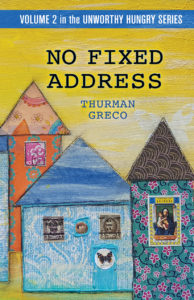Robyn
Robin gracefully sat in front of the closet and helped the shoppers choose a couple of items. Robyn lived in Mt. Tremper. Her living situation seemed to be somewhat precarious because every few months she would be looking for a new place to live. I think she lived in her car a couple of times.
During shopping lulls, Robyn addressed envelope after envelope after envelope for the fundraising letters we sent out several times each year. So, really, Robyn worked 2 jobs in the hallway: Items of Dignity and fundraising.
One afternoon Robyn came to my home. “Phoebe died yesterday Thurman. I need a place to bury her”. We found a quiet place in my garden under a Japanese Willow tree. She and Barry dug a grave and placed Phoebe, her beloved cat, wrapped in a rug, in the freshly dug hole. After all the earth had been placed over Phoebe, Barry emptied a large bag of mulch over the grave and I offered a prayer.
The next morning, as I walked by the area, I saw that Robyn had placed a cross as a headstone. There was also a little bouquet of fresh flowers for Phoebe placed on the grave.
Thanks for reading this post.
Peace and food for all.
Thurman Greco
Woodstock, NY
For The Most Part, Everyone Working In A Pantry Needs Healing on Some Level
“Pantries offer companionship, exercise, meaning, and purpose.”
Janet Poppendieck
No one just wakes up one day and says “I think I’ll go down to the local food pantry and volunteer”. People spending time in pantries, either as volunteers or shoppers, travel down a path toward a pantry. For the most part, the people need healing on some level.
Some needed physical healing. Volunteers occasionally came to the pantry so ill they were barely able to make it into the building. When this happened, I had a specific job for them. They were stationed at the Items of Dignity Table offering toilet paper, shampoo, razors, etc. Shoppers were allowed to take one roll of toilet paper and one other item.
For several months we had a volunteer who was excellent with the shoppers. Each week, Diane slowly walked the 2 blocks to the pantry and then worked in the hallway a couple of hours until she got enough energy to return home. “Don’t forget your roll of toilet paper, Judith. We’ve got some hand cream today. Can you use that or would you prefer tooth paste?”
When she finally couldn’t work in the hallway anymore, we had no one for the station. So, I relied on Robyn to help.
Thank you for reading this post.
Our next post will focus on Robyn and the many tasks she performed.
Peace and food for all.
Thurman Greco
Family of Woodstock Comes to the Pantry’s Rescue Two Years in a Row
Family of Woodstock was a real lifesaver for our pantry those first two Decembers I was the coordinator. The first year word spread that our shelves were empty. I got a call from Tamara Cooper.
“Thurman, can you come over here immediately? We just got a donation of food from someone and we have no place to put it. If you come over right now, you can have it all.”
Can I come over immediately? WOW I was there! It was glorious! I stuffed my car with grocery bags filled with canned and boxed goods of every kind. Thank you Tamara Cooper.
In October of the following year, I saw Michael Berg at a meeting at Mohonk Mountain House. I went over to him, introduced myself, and told him that Decembers were grim in our pantry. In December I got another call from Family. This time we were given a large number of Hannaford’s holiday gift boxes filled with pasta, tomato sauce, tuna fish, chicken noodle soup, etc. Thank you Michael Berg. Thank you to everyone at Family of Woodstock. Thank you to Hannaford’s. And, thank you to everyone who buys a gift box of food for the hungry at Hannaford’s.
By 2010, I was ready for August and December. I finagled a storeroom out of the building committee of the Woodstock Reformed Church. I even got permission for a refrigerator to go in it. The storeroom effort was a total scene – especially the refrigerator. I got permission from the pastor’s secretary who gave me the go ahead because everyone was out of the building.
Looking back at the whole event, I realize that Divine Guidance removed everyone from the building that morning. If anyone had been there the pantry would never have gotten even the storeroom…much less the refrigerator. Thank you God.
Except for the stress that my presence in this space (which was severe) caused the building committee and church members, the storeroom was a wonderful addition to the pantry. We were now able to order food for advance needs during lean months and the refrigerator, even though small, stored eggs.
The storeroom made all the difference. As my grandmother would have said “We were cooking with gas over at the Good Neighbor Food Pantry”.
Thank you for reading this blog post.
Peace and food for all.
Thurman Greco
Woodstock
Grocers, & Manufacturers Can Get By With A Lot Fewer Dumpsters If They Donate The Food And Let The Food Bank Truck Come By And Pick It Up.
All these donations going to food pantries, shelters, etc., are a real two-way street. Donating food is a break-even proposition for manufacturers.
To my way of thinking, it’s more advantageous for a farmer, grocer, or food manufacturer to donate the food to a Food Bank. All the food coming into the Food Bank has been diverted from a landfll. One advantage (or disadvantage, depending on how you look at it) to donating the food is that there are fewer dumpsters for people to dive in.
Some months I’d be lucky and get maybe 80% of what I needed. Other months I would get next to nothing that I needed. When that happened, I thought ahead and got what was available. Hands down, the most challenging month to get food was August because the food drives and food donations are seasonal. I finally decided that food donations are down in the late summer because nobody thinks of Food Banks and Pantries when they’re on vacation. One August, I bought 25 cases of water because I could get them and everything else was either scarce or nonexistent. That water came in very handy after Hurricane Sandy visited.
The Food Banks send out refrigerated trucks to pick up the excess. They get it to the warehouse where volunteers sort it and make it available to agencies as quickly as possible. The goal is to feed the hungry with the excess.
The second most challenging month is December. The first two Decembers I was the coordinator were dismal in the pantry because I hadn’t yet learned how to stockpile the food in advance. I was unprepared for this because, for one thing, I didn’t even have a storeroom to put the food in.
When the months were lean at the pantry, I made extra trips to Latham and returned with fresh produce. Fresh fruits and vegetables covered “a lot of ills” in the pantry because the shoppers didn’t have the money to buy fresh foods and they were always hungry for something fresh.
Thanks so much for reading about the food pantry.
Peace and food for all.
Thurman Greco
Woodstock, NY
Mike and Mike and the Air Conditioner
The pantry made demands on all of us. For one thing, there were guidelines, rules, boundaries, and no-nos, handed down by not only health codes, the Food Bank guidelines, HPNAP guidelines, but the building rules.
The building committee had strict rules about what hours we could be in the building, where the cardboard could go, when and where we could use what portion of the parking lot, where the people could stand in the overcrowded hallway, what food could or could not be stored where, when the produce and bread could come in the building, how many chairs could be placed in the hallway, etc.
I was in the pantry arranging the produce on the shelves one summer evening in the month before the building committee limited our hours in the building so severely.
The night was warm for Woodstock and I put a box fan on the sill in each of the 3 windows to keep the air moving in the pantry in an effort to retard the rotting of the produce, the lettuce, tomatoes, greens, and herbs.
Mike Cooter stomped in the room with a serious scowl on his face. His body posture shouted “anger”. Cooter was a member of the building committee and everyone connected with the pantry and the church knew that the building committee assumed total control over every detail of what happened in the building.
“Get these fans out of the windows.” he said.
“I’m trying to keep some of the produce from rotting so we’ll have fresh food for the shoppers tomorrow” I replied. “We lost 50% of our produce last week. We need the fans to keep the food cool.”
“Get the fans out of the windows NOW” he yelled. Cooter had gone from disapproving to threatening.
And I was scared.
Luckily for me, Mike Lourenso was standing in the shadows. He stepped out into the light.
“Back off Cooter” Mike said with an air of authority. “I was a Brooklyn cop for 23 years. Calm down now or I’ll take you down.” I wasn’t sure what “I’ll take you down” meant but I really liked the sound of those words.
Cooter took a deep breath and backed out of the small room. He took another couple of deep breaths and appeared to be accepting what he had just heard from Mike Lourenso.
Cooter returned to the room. “We need to fix this problem now Cooter. She’s driving 90 miles round trip every week for a truckload of produce and then losing half of it here in this room because of the heat.
Can we have an air conditioner?”
Cooter appeared to be thinking about – and considering – the request.
“Okay” said finally. He appeared to have reluctantly come to terms with the situation.
“Get those fans out of here now and get an air conditioner in a window now. Put it in that window” he said as he pointed to a specific window.
“Now? It’s after 9:30.”
“Yeah. NOW.”
“Okay, I’ve got one in my home. I’ll go get it and we’ll put it in tonight.”
And he did. He drove to his home, took a window unit out of a bedroom, and returned to the pantry with the unit and an electric drill. Together, we installed it at 10:30 that same night.
I, for one, was grateful for many things that night.
First, I was grateful for a volunteer who knew how to be a cop.
Second, I was grateful we could get our hands on an air conditioner fast – before Cooter changed his mind.
Third, I was really grateful that we were going to be able to have a better quality of fresh food to serve to our shoppers.
Peace and food for all.
Thurman Greco
Woodstock
Bad Back Bob
Bad Back Bob was a shopper/volunteer always available to help. A veteran with disabilities, he suffered from nightmares, serious spinal issues, an occasional seizure, PTSD, migraines, etc. He often came early to the pantry on Wednesday to help unload the food. We all felt that he shouldn’t do this lifting because of the back issues but he really wanted to feel like he was helping in some way.
“Leave my back to me Thurman. I’m here to help. I just want to be a part of this pantry.”
At one point, because of the seizures, Bob was unable to drive to the pantry so he got a ride or hitch hiked over from Motel 19 to help.
Bob rode with us to Latham to the Food Bank whenever we asked.
Bob worked in the garage distributing meat whenever we asked.
Bob helped break down hundreds of boxes on Wednesdays whenever we asked.
Bob helped get the food in the pantry on Tuesday mornings whenever we asked.
Bob worked in the pantry during the monthly food delivery whenever we asked.
In short, Bob did everything he could to help keep the pantry going, whenever we asked.
When Bob finally returned to Model 19 after a shift, he would cook up the food that he shopped for and share it with other residents who couldn’t make it to the pantry that day.
It’s important to note here that Veterans have special needs. They return home from wars with illnesses, injuries, and they need housing, employment, counseling, health care. They and their families have many adjustments to make as they get to know one another again after the vet has been in this terrible struggle in Afghanistan and Iraq. The recovery can take years. We still see homeless Viet Nam vets.
Gioia Timpanelli
“No one in the world, yes, in the world, can tell a story better than Gioia Timpanelli”. – Frank McCourt
One afternoon I got a call from Ann King. “Hi Thurman. I just heard from Gioia Timpanelli. She wants you to call her. She wants to do a show for the pantry. She wants to do a storytelling evening.”
WOW! One call led to another and Gioia Timpanelli worked some real magic. She….Mary Savage, Dawn Meola, Laurie McGrath, Jean Druffner, Janet Carles, Karen Pillsworth, and Ann Epner….created a totally mystical and magical evening for us.
The evening began with a surprise visit from the Rosendale Marching Band.
Then, each woman told a story which transported us all to another time and place. Each story carried magic. Each story hinted of a miracle in each of our lives. The message was especially important to us as pantry people. Our pantry moved day-by-day on the hope and reality of miracles.
Gioia put together this evening from beginning to end.
Gioia gathered together her storytelling friends. They came from far and wide to tell a story for the pantry.,
Gioia went to the Daily Freeman, the Kingston newspaper, and got a gorgeous front page spread over the fold with a wonderful photo (taken by her daughter, no less).
Gioia managed the rehearsals.
Gioia hosted the evening.
And then, finally, Gioia managed the donations.
This was such a gift for our pantry. Gioia is a national treasure. For her to orchestrate this evening said volumes about the needs of the hungry. For me, this evening not only brought in much needed money, it brought validation to our cause, our determination to feed the hungry.
Blessings to Gioia…and storytellers the world over.
Peace and food for all.
Thurman Greco
The Food Coming to Our Pantry from the Food Bank Has Been Diverted From a Landfill
There’s absolutely no excuse for anyone in our great country to go hungry.
The third category was Donated Food. This was usually canned or boxed food in really good condition which manufacturers couldn’t sell or supermarkets had overstocked.
All the cans had labels in good condition and none of the cans were dented.
Popular donated items included Barilla Pasta, Breyer’s Ice Cream, Cheez-It Crackers, Chobani Yogurt, Hellman’s Mayonnaise, Hunt’s Products, Kellogg’s Cereals, Lipton Teas, Nestea, Pepsi products, Progresso Soup, Suave Shampoos, Tide soap, Triscuit Crackers, V-8 Juices.
Co-op was the fourth category. The food in this category was offered at more or less grocery store prices. Coop food supplements the donated food inventory. The Coop food enables the Food Bank to have an inventory which meets the needs of the agencies. Except for toilet paper and eggs, I rarely bought from this category because our pantry simply couldn’t afford the costs. Even so, the eggs were a few cents cheaper than anywhere else and the toilet paper was important to the households with no funds.
Eggs were always a challenge. They’re only available through the pantry in the Co-op section of the catalogue. They were rarely in the refrigerator case at the Food Bank when we went for produce and dairy products weekly. Purchasing the eggs locally was hard because we needed about 150-200 dozen eggs at a time. My main source when we couldn’t connect with the food bank was Aldi. They were about the only store that really didn’t care how many dozen eggs we bought. Price Chopper in Saugerties was a real lifesaver a couple of times also.
One winter I was having a really tough time getting soup. Then, Progresso donated a large load of soup to the Food Bank. Hurrah! After hurricane Sandy, ConAgra sent a generous load of canned goods to the food bank. To this day, two favorite words in my vocabulary are Progresso and ConAgra.
Thanks for reading these Food Bank posts. I hope they’re answering questions for you. Tomorrow’s post will begin with a discussion of dumpster diving and months when we had almost nothing.
Peace and food for all.
Thurman Greco
Woodstock, NY
Bonnie, Michelle, Nora and the Salvage Food Order at The Food Bank
In yesterday’s post, I started the monthly order.
In a good month, I ordered 16 cases each of a large variety of canned/boxed goods: peanut butter, canned beans, canned refried beans, canned green beans, pasta, and oatmeal for example.
In a bad month, I would only be able to get my allotment of a couple of things: tomato sauce, and dried plums, for example.
Bonnie, my primary contact for the Food Bank food orders, spent time telling me politely on Monday and Tuesday that most of what I wanted was already out of stock. As the week progressed, the outlook usually improved. By Friday, some of the stock had been replenished, new merchandise was on the shelves and the order was as good as it was going to get. Michelle and Nora were also available when Bonnie’s line was busy.
These 3 women, Bonnie, Michelle, and Nora, spent their work days on the phone listening to desperate pantry coordinators, soup kitchen managers, shelter directors, ordering food. While they were assisting an agency person on the phone there was always a list of people waiting for their turn to add their needs to the day’s list.
Generally, food items were depleted as fast as they came on the computer screen. That’s why we called throughout the week. Nothing was ever available for more than a day or 2.
“We just got in a shipment of USDA” was music to my ears.
Then would come the order for salvage bulk food categories. These were banana boxes filled with 40 pounds of canned/boxed/bottled foods in specific categories such as fruits and vegetables, condiments, juices, pantry, soup, etc. As a pantry, I was able to get this food at 16 cents per pound. These boxes were wonderful. They were wonderful to me, anyway.
In reality, they were something else altogether.
Salvage food is made up of the dented cans and crumpled boxes that are pushed aside at the grocery store.
They are either collected at the store and brought over by the store itself to the Food Bank or a Food Bank truck drives around picking the food up and taking it to the Food Bank. Food Bank volunteers clean and sort these items. Salvage boxes offer variety to pantries, soup kitchens, and shelters. This is where we get the occasional spice or herb, can of olive oil, box of cooking chocolate, jar of pickles.
Another favorite refrain I liked to hear from Bonnie or Michelle was “I can let you have 5 boxes of pantry today.” Once I was able to order 24 boxes of salvage products. I felt like I was being rewarded by the universe for something I must’ve done right. I never quite figured out what it was that I did. But this I know: life was beautiful that week.
Thanks for reading this post.
There is absolutely no excuse for anyone in our country to go hungry.
Peace and Food for all.
Thurman Greco
Woodstock, NY
Peace and food for all.
Thurman Greco
Woodstock, NY
Paul Shultis, Jr., and The Men of Woodstock and 4 Categories of food
In the last post Gene Huckle suggested that I go to a Woodstock Town Board meeting and try to get a truck.
So I did. I went to a Town Board meeting and asked the Town to drive a truck over and pick up the food for the pantry. What did I have to lose, right? Well, that request went nowhere. However, townspeople responded. Calls came in from area residents. And several volunteered monthly.
After that, I would put an item in the “Woodstock Times” newspaper on the week before the shipment arrival asking for volunteers. People just showed up at the Hannaford’s.
Paul Shultis, Jr., became a “regular”. He showed up every month driving a heavy duty pickup with a trailer attached to the rear. His rig could carry 4,000 pounds easy. I loved, loved, loved the sight of that rig coming up to the pantry door filled with food. Paul Shulti, Jr., took time off from work every month so he could caravan the food from the Hannaford’s to the pantry.
We would never in a million years have been able to get the food to the pantry without the generosity and dedication that Paul and the townspeople showed as they arrived at the Hannaford’s parking lot every month.
Each month I spent the week before the delivery day calling the Food Bank daily to place the food order. I started the order on Monday and then added to it throughout the week. On Monday I ordered food from four different categories:
USDA
Donated Foods
Salvage Food
Coop Food
I ordered everything I could get from the free United States Department of Agriculture (USDA) food first. The USDA food is part of the government’s farm subsidy program which includes, among other things, distributing excess food to the hungry.
The next post will focus on how the Food Bank works to get the food for us.
Thanks again for reading this blog/book.
Peace and food for all.
Thurman Greco
Woodstock
I ordered






